NCERT Solutions, Question Answer and Mind Map for Class 10 Social Studies History Chapter 3, “The Making of a Global World,” is a study material package designed to help students understand the economic, political, and cultural changes that took place during the period of globalization from the late 19th century to the early 20th century.
The NCERT Solutions provide detailed explanations and answers to the questions presented in the chapter. The solutions cover all the topics in the chapter, including the growth of industrialization, the impact of imperialism on the world economy, the emergence of new forms of communication and transportation, and the role of international organizations in shaping the global order. They also provide tips on how to answer different types of questions, including short answer, long answer, and multiple-choice questions.
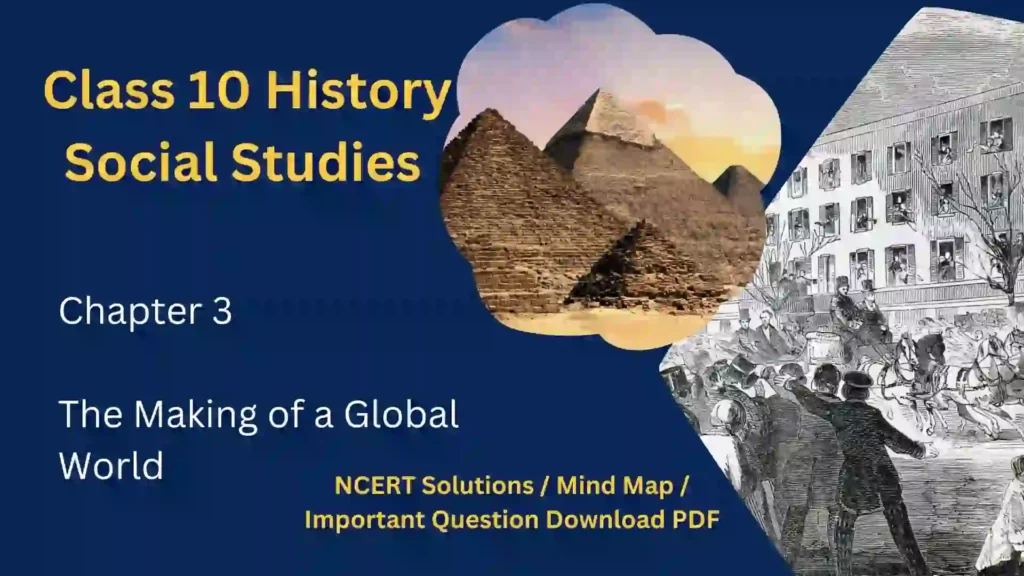
The question-answer section of the chapter covers a wide range of topics, from the growth of capitalism and the expansion of trade to the impact of globalization on different regions of the world, including Asia, Africa, and Latin America. It also includes questions on the emergence of new cultural forms, such as cinema and music, and the impact of these forms on global culture.
The mind map provides a visual representation of the key topics covered in the chapter, allowing students to understand the connections between different concepts and ideas. The mind map covers the economic, political, and cultural dimensions of globalization, including the growth of multinational corporations, the role of the state in regulating the global economy, and the impact of globalization on cultural diversity.
NCERT Solutions / Notes Class 10 Social Studies History Chapter 3 The Making of a Global World
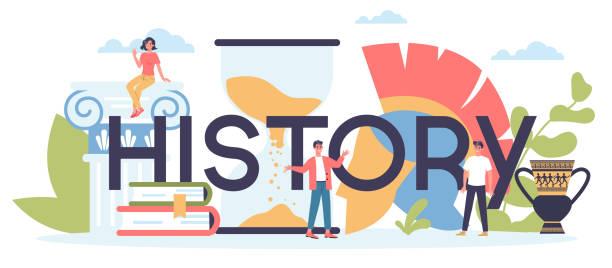
The Making of a Global World
Trade Routes, Goods and Trading Practices
The word ‘Globalisation’ is of recent origin. It refers to an economic system which has interlinked and integrated the world’s economies. However, ‘globalisation’ in its primitive forms did exist in the ancient, medieval and the early modern periods.
The Silk Route
The Silk Route was mainly a trade route which connected Asia with Africa and Europe. Silk was the chief commodity which was traded on this route. However, many other commodities such as gold, silver, precious stones, wool, cotton and carpets were also traded on this route. This route also enabled cultural exchanges from one country to another. Many Buddhists, pilgrims and priests travelled on this route in search of spiritual and religious knowledge.
Food Travels
- When people travelled far across the countries, they carried not only their ideas, goods and commodities but also their food and food habits.
- Various food items and seeds were carried from one part of the country to the other. These food items then assumed different names and forms in different countries. For example, it is believed that noodles became spaghetti after they were taken from China to the West.
- Many common and staple foods such as potato, tomatoes, chillies and maize were not known in many countries in the ancient period. These food items were introduced in Asia and Europe after the continent of America was discovered.
NCERT Solutions for Class 6th SSt
- Chapter 1
- The introduction of these food items changed the lifestyle of Europeans. Europe’s poor began to eat better and live longer with the introduction of the potato.
Conquest, Disease and Trade
- The Discovery of sea routes and geographical explorations significantly changed the geography and lifestyle of Europeans in particular.
- After the discovery of America, its vast lands, minerals and abundant crops changed the lives of people living elsewhere. For example, silver mines in present-day Peru and Mexico financed European trade with Asia.
- The Portuguese and the Spanish began to conquer and make inroads into the American continent. They were able to conquer the Americas not because of their superior weapons but because of the germs that they carried along with them.
A painting depicting the death of Native Americans because of the outbreak of small pox
- The natives of America were cut off from the world and they had no immunity against the diseases which came from Europe. Small pox, to which the Europeans were immune, killed thousands of native Americans and paved the way for the colonisation of America.
- Many Europeans migrated to America in order to escape religious persecution and to begin a new life. Many cotton and sugarcane plantations were established in America where several Africans captured as slaves worked. The agricultural and mineral wealth of America began to dominate the world economy.
- India and China were among the richest countries in ancient and medieval times. However, by the beginning of the eighteenth century, their position began to decline and Europe emerged as the centre of world trade.
The Nineteenth Century
There were significant political, cultural and technological changes in the nineteenth century in Europe.
Changes in Economy
- In the beginning of the nineteenth century, the demand of food grains increased in Great Britain. This increased the prices of food grains. Under pressure from landowners, the Government put a ban on the import of corn, which came to be known as the Corn Laws.
- This further increased the prices of food grains. This led the Government to scrap the Corn Laws. Thus, food began to be imported into Britain in such large quantities that British agriculture was unable to compete with imports. Many agricultural labourers migrated to cities in search of work.
- The reduction in food prices in Britain increased consumption. After the beginning of the Industrial Revolution, the average income rose. Lands were cleared in Eastern Europe, Australia, America and Russia to meet the food demands of Britain. This also led to the development of ports, transport and settlements in these regions.
- Many Europeans also migrated to Australia and America as labour was in short supply and in search of a better future.
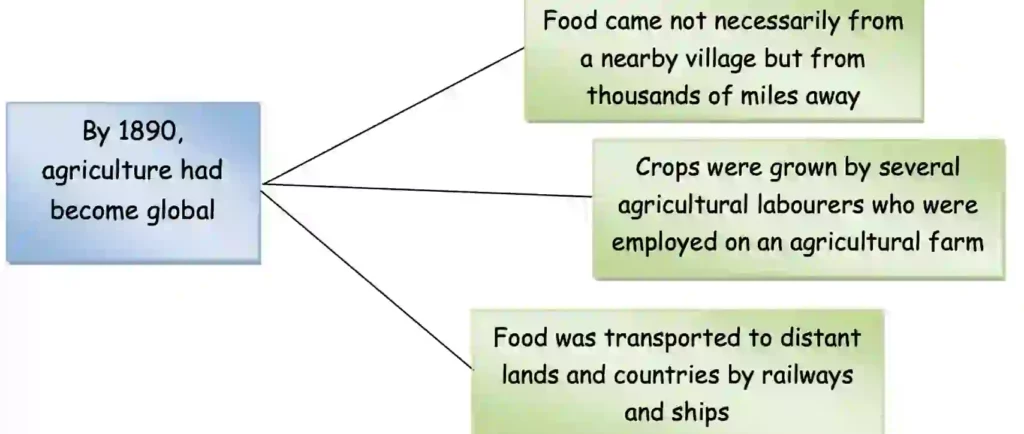

Role of Technology
The railways, steamships and telegraph were some important inventions of the late modern period. These inventions came to be increasingly used in colonies to further help in the transport of food grains and raw materials.

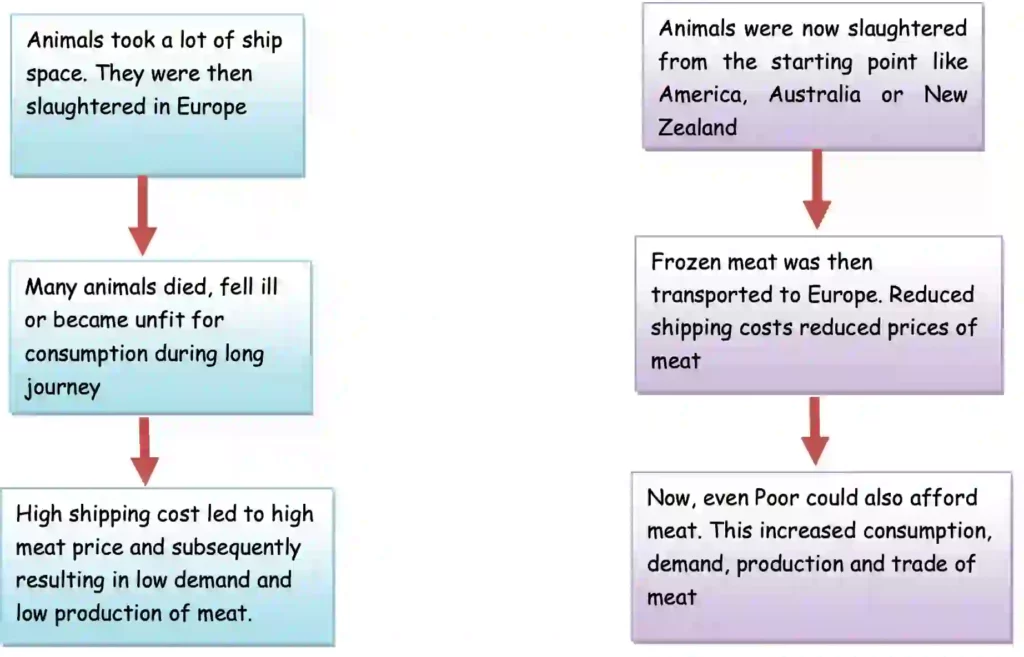
Availability of meat at cheap prices promoted social peace within the country and support for imperialism abroad.
Colonialism in the Late 19th Century
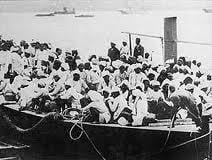
- One negative result of expansion of trade and industrial growth in Europe was the spread of colonialism in many countries of Asia and Africa. The big European nations divided the African continent among each other in 1885 at Berlin. Britain, France, Germany, Belgium and USA were some major African landholders.
- Initially, it became difficult to find labour in Africa. However, several methods were used by the Europeans to recruit and retain labour in Africa. These were:
- Heavy taxes were imposed which could be paid only by working for wages on plantations and mines.
- Inheritance laws were changed so that peasants were displaced from land. Only one member of a family was allowed to inherit land, as a result of which the others were pushed into the labour market
- Mineworkers were also confined in compounds and not allowed to move about freely.
NCERT Solutions for Class 6th SSt
- Chapter 1
- Later, the spread of a cattle disease called rinderpest killed about 90% of cattle in Africa. This loss of cattle destroyed the African livelihood forcing the Africans to work for European planters and mine owners.
Indentured Labour
An indentured labour is a form of labour in which a bonded labourer works under contract for an employer for a specific amount of time. The labourer has to pay off his passage or travel expense to a new country or home.
- In the nineteenth century, many indentured labourers were sent from India and China to various regions of the world to work on plantations, mines and in road and railway construction projects.
- The indentured labourers had to sign a contract in which they had to work for five years on their owners plantations before returning to their lands. If they left their jobs before the end of their tenure, the owner had the right to send them to jail.
- Most of the indentured labourers came from Uttar Pradesh, central India, Bihar and the dry regions of South
India. Many Indian workers migrated to the Caribbean Islands, Mauritius and Fiji. These labourers worked under extremely harsh conditions and did not earn enough. Most of them were recruited by the agents who provided them with false information on the final destination, mode of travelling and living and working conditions. Indentured labour became a new system of slavery.
However, even during such harsh working conditions, the indentured workers discovered their own ways of surviving.
- Many of them escaped into the wilds while others developed new forms of individual and collective self-expression, blending different old and new cultural forms.
- ‘Chutney music’, popular in Trinidad and Guyana, is a creative contemporary expression of the post-indenture experience.
- In Trinidad the annual Muharram procession was transformed into a riotous carnival called ‘Hosay’ (for Imam Hussain) in which workers of all races and religions joined.
- Similarly, the protest religion of Rastafarianism (made famous by the Jamaican reggae star Bob Marley) is also said to reflect social and cultural links with Indian migrants to the Caribbean.
From the 1900s India’s nationalist leaders began to oppose the system of indentured labour migration as abusive and cruel. It was abolished in 1921.
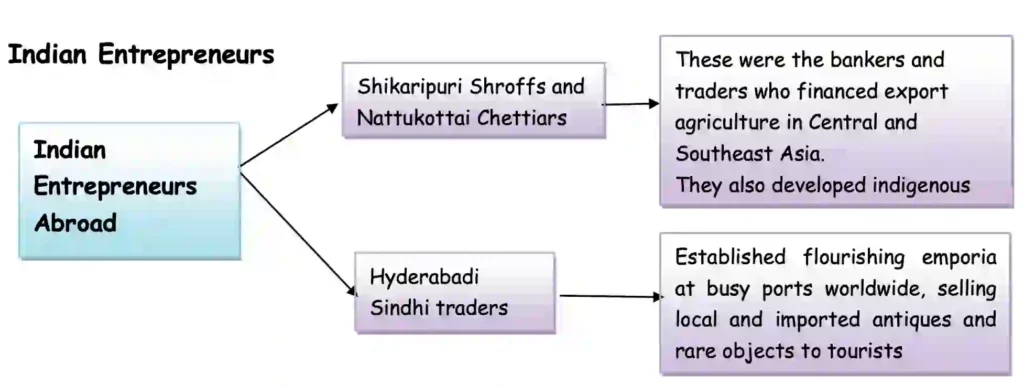
Indian Trade, Colonialism and the Global System
- The British Government imposed several restrictions on the import of Indian cotton clothes into Britain to protect local industries. The tariff duties however were removed on the British mill- produced cloth imported into India.
- This led to the decline in the Indian textile industries which were not able to face competition from the cheap mill-produced cloth from Britain. The Indian textiles also faced competition from British machine made goods in other international markets.
- While the export of Indian cotton cloth declined, the export of raw materials such as cotton, indigo and opium increased. In India, the value of British exports was higher than that of British imports. Britain thus maintained a favourable balance of trade with India. It helped Britain to balance its trade deficit with other countries, to pay its officers in India, to pay interest on India’s external trade and to pay the pensions of the British officials in India. This resulted in the drain of Indian wealth to Britain.
The Economy during the First World War
- The First World War was fought between Britain, France and Russia (later also joined by the USA) on one hand and Germany, Austria–Hungary and Ottoman Turkey on the other hand. The war caused large-scale economic changes in the world.
- Machine guns, tanks, aircraft and chemical weapons were used on a large scale. During the war, many industries were producing goods related to the war. Women began to work as men went to the battlefield to fight the wars.
- Britain borrowed large sums of money from the banks and the public of the United States. After the end of the war, the citizens of the US had owned more overseas assets than in the US.
Post-War Recovery
- By the end of the war, Britain was heavily in debt. The end of the war led to an increase in unemployment. Production also decreased.
- The revival of wheat production in Canada, America and Australia led to the fall in the prices of wheat. This led to a decline in rural income and high debts for farmers.
- The US was quick to recover from the effects of the First World War

The Great Depression of 1929-30
- A great economic depression hit the United States and other European countries in 1929. There was decline in the production of industrial goods, employment opportunities, incomes and trade. Farmers were worst affected because of the decline in food grains.
- Countries which depended on US finances faced acute crises. The withdrawal of loans from the US led to the failure of major banks in Europe and the value of the pound deteriorated. The attempts by the US to protect its trading interests by increasing import duties also hit the world markets.
- The depression also hit the US hard. The conditions of farmers, workers and the middle class worsened.
- Agricultural overproductions, decrease in prices of agricultural goods and the refusal of the USA to grant loans to other countries finally resulted in the Great Depression.
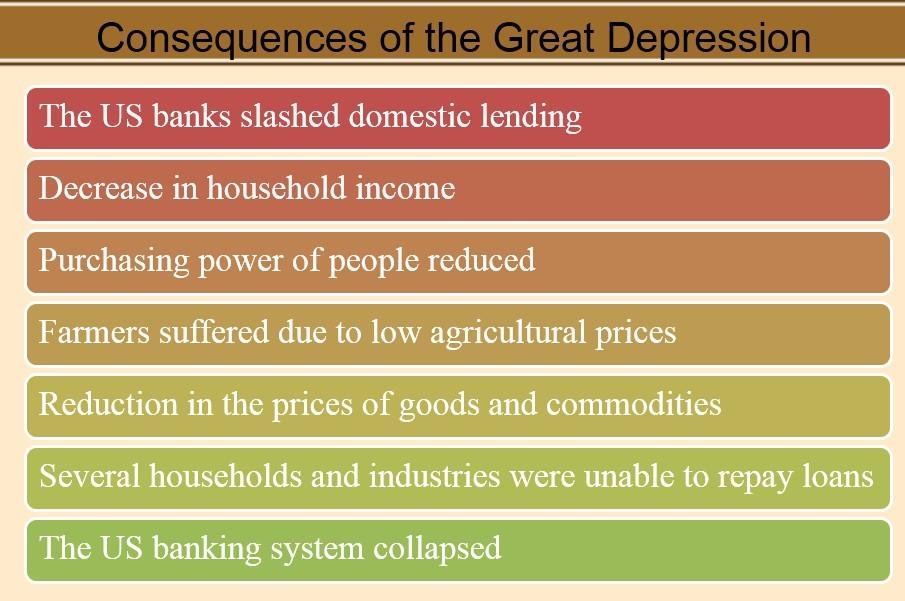
The Great Depression – Impact on India
- Indian trade was hit hard by the Great Depression. India’s exports and imports were halved. By 1934, the prices of wheat fell by 50%.
- The prices of food grains declined, but the Government refused to reduce the taxes.
- Peasants who produced commodities for the world market such as cotton and jute suffered great losses. Rural indebtedness increased, and many farmers lost their lands.
- The depression did not impact urban Indians much. Decrease in the prices of food grains benefited fixed salaried employees. Investments in industries also grew as the Government protected the industries by imposing tariffs under the mounting pressure of the Indian nationalists.
The Second World War and Recovery
- The Second World War broke out in 1939. The destruction in this war was larger than the previous war. This war saw the rise of two powerful nations—the United States and the Soviet Union of Russia.

- The governments of the European and American nations realised that for economic recovery, it is important to preserve economic stability and guarantee full employment to the people. The conference was held at Bretton Woods in USA in 1944 to discuss ways to achieve these aims. This system came to be known as the Bretton Woods system.
- International Monetary Fund (IMF) was set up to finance the post-war reconstruction process. The World Bank and the IMF were controlled by the Western powers, especially by the US.
- The Bretton Woods system led to the beginning of growth of trade and income in many western industrial regions and in Japan.
Decolonisation
- After the end of the Second World War, many Asian and African countries became independent. These countries however emerged poor as these countries were exploited by colonial powers.
- The World Bank and the IMF began to shift their focus towards the development of newly independent nations. However, many western nations also secured the rights to exploit the natural resources of the poor countries and further exploited them.
- Many developing nations did not benefit from the rapid growth of the western nations, and thus, they organised themselves into a group of 77 or G-77 to demand a new international economic order (NIEO) which could also protect their trading interests in the long term. By NIEO, the third world countries aimed for a system that will give them a control over their own natural resources, development assistance, fairer prices for raw materials and a better access of their goods in the markets of the developed countries.
NCERT Solutions for Class 6th SSt
- Chapter 1
Beginning of Globalisation
- Because of the rising costs of goods, the US Dollar began to depreciate. This led to the collapse of fixed exchange rates (when the rates of exchange are fixed and the Government interferes in the system to keep them fixed) and the introduction of floating exchange rates (the rates are not fixed as they fluctuate depending on the demand and supply of currencies in the foreign markets; the Government does not control the rates).
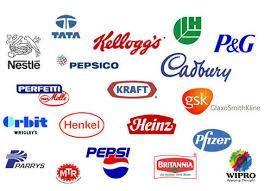
- The developing countries were forced to borrow money from the western commercial banks and private lending institutions. This increased debt traps, poverty and lower incomes in borrowing countries.
- As the costs of running production and labour became expensive in the western nations, these countries began to shift their centre of production to the Asian and African nations.
- The collapse of the Soviet Union brought many socialist countries into the world economic fold.
- Because the wages of workers were extremely low in China, many traders and businessmen set up their industries there.
- The shifting of industries to low-wage countries resulted in larger trade and flow of capital from the developed to the developing nations. Many countries such as China, India, Brazil and the Philippines have seen rapid economic construction and transformation.
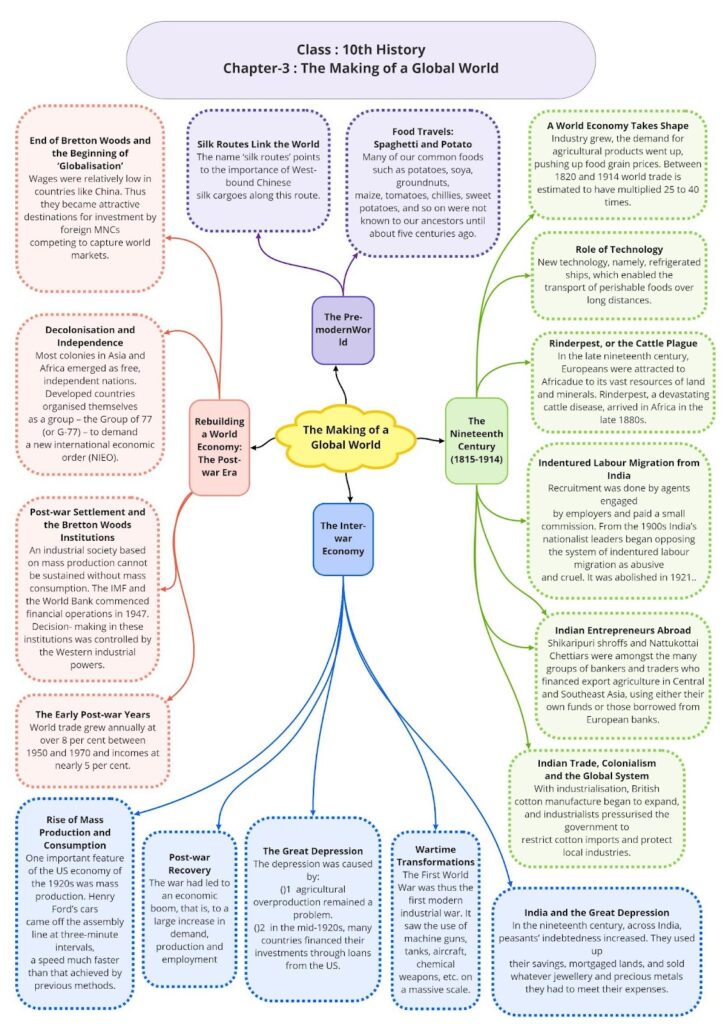
Class 10 Social Studies History Chapter 3 The Making of a Global World Important Questions
Multiple Choice Questions-
- People livelihood and local economy of which one of the following was badly affected by the disease named Rinderpest.
(a) Asia
(b) Europe
(c) Africa
(d) South America
- Which of the following places was an important destination for indentured migrants?
(a) Florida
(b) Melbourne
(c) Carribbean island
(d) Mexico
- The group of powers collectively known as the Axis power during the Second World War were:
(a) Germany, Italy, Japan
(b) Austria, Germany, Italy
(c) France, Japan, Italy
(d) Japan, Germany, Turkey
- Who among the following is a Nobel Prize winner?
(a) V.S. Naipaul
(b) J.M. Keynes
(c) Shivnarine Chanderpaul
(d) Ramnaresh Sarwan
- Which of the following statements correctly identifies the com laws?
(a) Restricted the import of corn to ; England
(b) Allowed the import of com to England
(c) Imposed tax on com
(d) Abolished the sale of com
- Which of the following is the direct effect of Great Depression on Indian Trade?
(a) Peasants and farmers suffered.
(b) Indian exports and imports nearly halved between 1928-1934.
(c) Peasants’ indebtedness increased.
(d) Led to widespread unrest in rural India.
- Which of the following enabled the Europeans to conquer and control the Africans?
(a) Victory in war
(b) Control over the scarce resource of cattle
(c) Death of Africans due to rinderpest
(d) Lack of weapons in Africa to fight against the Europeans
- Who discovered the vast continent, later known as America?
(a) Vasco da Gama
(b) Christopher Columbus
(c) V.S. Naipaul
(d) None of these
- Until 18th century which two countries were considered the richest in the world?
(a) India and China
(b) China and Japan
(c) England and France
(d) England and Italy
- Why were the Europeans attracted to Africa?
(a) By its natural beauty
(b) By the opportunities for investment
(c) For its vast land resources and mineral wealth
(d) For recruitment of labour
- Transport of perishable goods over long distance was possible because of
(a) improved railways
(b) airline services
(c) refrigerated ships
(d) steam ships
- The World Bank was set-up to
(a) finance rehabilitation of refugees.
(b) finance post war construction.
(c) finance industrial development.
(d) help third world countries.
- Most Indian indentured workers came from: [CBSE 2011]
(a) Eastern Uttar Pradesh
(b) North-eastern states
(c) Jammu and Kashmir
(d) None of these
- Who adopted the concept of an assembly line to produce automobiles?
(a) Henry Ford
(b) Karl Benz
(c) V.S. Naipaul
(d) Samuel Morse
NCERT Solutions for Class 6th SSt
- Chapter 1
- The First World War was fought mainly in
(a) Asia
(b) Europe
(c) America
(d) Africa.
Very Short:
- What is globalisation?
- How were human societies interlinked in ancient times?
- Which was the earliest active coastal trade link?
- Name one earliest form of currency.
- To which century the long distance spread of disease-carrying germs may be traced?
- Mention one example of vibrant pre-modem trade and cultural link between distant parts of the world.
- What does the name ‘silk routes’ point to?
- Who took pasta to Sicily?
- Name the foods that were introduced in Europe and Asia after the discovery of America by Christopher Columbus.
- What was the effect of potatoes on the lives of the poorest in Europe?
Short Questions:
- When did the Great Irish Potato Famine take place and what were its results?
- How did the discovery of America in the 16th century transform trade and lives every where? Give one example.
- What was the most powerful weapon of the Spanish conquerors of America?
- Why did the Europeans leave Europe for America in the nineteenth century?
- What was the position of China and India among the countries in the 18th century?
- By the eighteenth century in America, how did the plantations work and what was grown there?
- Which were the three types of movements or flows within international economic exchanges?
- State any one reason that was responsible for the increased demand for food grains in Britain in the late eighteenth century.
- What were Corn Laws? Why were they passed?
- Mention two steps that were taken to meet the increased demand for food in Britain.
Long Questions:
- Describe how human societies have become steadily more interlinked in the ancient times.
Or
Mention any three sources of interlinkage between nations in ancient times
- “Food offers many examples of long distance cultural exchange.” Support your answer with three examples.
- Explain with example, how the new crops could make the difference between life and death for people. Explain with an example from Ireland.
Or
Show the importance of new crops for the poor.
- Describe the main features of the pre-modern world before the sixteenth century. How did it change with the discovery of new sea routes to America? Give any three examples to explain the statement.
- Describe three types of movements or flows within international economic exchanges in the nineteenth century. What were its effects?
Assertion Reason Questions:
- In the following questions, the Assertions (A) and Reason(s) (R) have been put forward. Read both statements carefully and choose the correct answer from the below:
(a) Only Assertion is true.
(b) Only reason is correct
(c) Both Assertion and Reason correct, and Reason is correct explanation of Assertion.
(d) Both Assertion and Reason correct, and Reason is not correct explanation of
Assertion.
Assertion (A) – As International prices crashed. Between 1928 to 1934 wheat prices in India fell by 50 percent.
Reason (R) – The depression immediately affected Indian trade. India’s export and import nearly halved between 1928 to 1934
- In the following questions, the Assertions (A) and Reason(s) (R) have been put forward. Read both statements carefully and choose the correct answer from the below:
(a) Only Assertion is true.
(b) Only reason is correct
(c) Both Assertion and Reason correct, and Reason is correct explanation of Assertion.
(d) Both Assertion and Reason correct, and Reason is not correct explanation of
Assertion.
Assertion (A) – Rinderpest arrived in Africa in the late 1880’s. It reached the Cape, African southernmost tip five year later. Along the way rinderpest killed 90 percent of the cattle.
Reason (R) – It was carried by infected cattle imported from British Asia to feed the Italian soldiers invading Eritrea in East Africa.
Case Study Questions:
- When the Second World War ended, large parts of the world were still under European colonial rule. Over the next two decades, most colonies in Asia and Africa emerged as free independent nations. They were, however, overburdened by poverty and a lack of resources, and their economies and societies were handicapped by long periods of colonial rule. The IMF and the World Bank were designed to meet the financial needs of the industrial countries. They were not equipped to cope with the challenge of poverty and lack of development in the former colonies. But as Europe and Japan rapidly rebuilt their economies, they grew less dependent on the IMF and the World Bank. Thus, from the late 1950s, the Bretton Woods institutions began to shift their attention more towards developing countries. As colonies, many of the less developed regions of the world had been part of Western empires. Now, ironically, as newly independent countries facing urgent pressures to lift their populations out of poverty, they came under the guidance of international agencies dominated by the former colonial powers. Even after many years of decolonization, the former colonial powers still controlled vital resources such as minerals and land in many of their former colonies. Large corporations of other powerful countries, for example, the US, also often managed to secure rights to exploit developing countries’ natural resources very cheaply.
- Why were the Bretton Woods Institutions established? Choose the correct option from the following:
(a) To promote the International Trade
(b) To reconstruct the economies damaged during the Second World War
(c) To improve the adverse Balance of Payment situation of the non-member countries
(d) All of the above
- What factors led to decolonisation after the Second World War? With reference to the above context, infer the appropriate option.
(a) After World War-II, European countries lacked the wealth and political support necessary to suppress the revolts.
(b) There were strong independence movements in colonies.
(c) Both (a) and (b)
(d) Financial needs of European countries were not favoured as they were colonial powers.
- Which of the following countries has an effective right of veto over key IMF and World Bank decisions? Select the best suitable option from the following reference to the context:
(a) France
(b) Australia
(c) Russia
(d) USA
- Why did the Bretton Woods Institutions shift their focus from industrial countries to colonies? Identify from the given options.
(a) As upliftment of poor countries was a central notion.
(b) Because industrial countries had rebuilt their economies.
(c) Because financial support was a need for the establishment of administration in colonies.
(d) As industrial countries tried to establish their control on Bretton Woods Institutions.
- How did Bretton Woods Institutions failed in maintaining the idea of decolonisation?
(a) The European rulers played a dominant role in Bretton Woods Institutions.
(b) As its focus was to improve the European industrial centres.
(c) Through Bretton Woods Institutions, European rulers continued their control over colonies resources.
(d) All of the above
ANSWER KEY
MCQ:
- Answer: c
- Answer: c
- Answer: a
- Answer: a
- Answer: a
- Answer: b
- Answer: b
- Answer: b
- Answer: a
- Answer: cs
- Answer: c
- Answer: b
- Answer: a
- Answer: a
- Answer: b
Very Short Answer:
- Answer: Globalisation refers to an economic system that has emerged for the last 50 years or so.
- Answer: In ancient times human societies were interlinked by travellers, traders, priests and pilgrims who travelled vast distances for knowledge, opportunity and spiritual fulfillment or to escape persecution.
- Answer: As early as 3000 BCE an active coastal trade linked the Indus Valley civilisations with the present day West Asia.
- Answer: Cowries (the Hindi cowdi or seashells) were used as a form of currency.
- Answer: Seventh Century.
- Answer: The silk routes are a good example of vibrant pre-modern trade and cultural links between distant parts of the world.
- Answer: The name ‘silk routes’ points to the importance of West-bound Chinese silk cargoes along the route.
- Answer: Perhaps Arab traders took pasta to fifth century Sicily, an island now in Italy.
- Answer: The foods were potatoes, soya, groundnuts, maize, tomatoes, chillies and sweet potatoes.
- Answer: The new crops of potatoes made a great change in the lives of the poor in Europe because they began to eat better and live longer. In Ireland poorest peasants became so dependent that when disease destroyed the potato crop in the mid 1840s, thousands died of starvation.
NCERT Solutions for Class 6th SSt
- Chapter 1
Short Answer:
- Answer:
The Great Irish Potato Famine took place during 1845-1849. As a result of it, around 1,000,000 people died of starvation in Ireland and double the number emigrated in search of work..
- Answer:
Precious metals, particularly silver, from mines located in present-day Peru and Mexico enhanced Europe’s wealth and financed its trade with Asia.
- Answer:
The most powerful weapon of the Spanish conquerors was not a conventional military weapon at all. It was the germs such as those of smallpox that they carried on their person.
- Answer:
The reasons were poverty, hunger, diseases, religious conflicts and persecution of religious dissenters.
- Answer:
- Until well into the eighteenth century, China and India were among the world’s richest countries.
- They were also pre-eminent in Asian trade.
- Answer:
- In America by the eighteenth century, plantations worked by slaves captured in Africa.
- They were growing cotton and sugar for European markets.
- Answer:
- Flow of trade i.e., trade in goods.
- Flow of labour i.e., migration of poeple in search of employment.
Movement of capital for short-term or long-term investments over long distances.
- Answer:
Population growth.
- Answer:
- The laws allowing the government to restrict the import of corn were known as Corn Laws.
- Under pressure from landed groups, the government had passed these laws.
- Answer:
- Lands were cleared in Eastern Europe, Russia, America and Australia to expand food production to meet the British demand.
- New harbours were built and old ones expanded to ship the new cargoes.
Long Answer:
- Answer:
It is true to say that the human societies have become steadily more interlinked in the following ways :
- From ancient times, travellers, traders, priests and pilgrims travelled vast distances for knowledge, opportunities and spiritual fulfillment or to escape persecution.
- They carried goods, money, values, skills, ideas, inventions and even germs and diseases.
- As early as 3000 BCE an active coastal trade linked the Indus Valley civilisation with present-day West Asia.
- For more than a millenia, cowries (in Hindi cowdi or sea-shells) were used as a form of currency. From the Maldives they found their way to China and East Africa.
- The long distance spread of disease-carrying germs are traced as far back as the seventh century. By the thirteenth century it had become an unmistakable link.
- From the ninth century, images of ships appear regularly in memorial stones found in the western coast, indicating the significance of oceanic trade.
- Answer:
Food offers many examples of long distance cultural exchange as mentioned below :
- Travellers and traders introduced new crops to the lands they travelled. Even ‘ready’ foodstuff in distant parts of the world might share common origins. For example, noodles travelled west from China to become spaghetti.
- Arab traders took pasta to fifth century Sicily (Italy). Similar foods were known to the Indians and Japanese people. Their origins cannot be ascertained, but the fact remains that there was long distance cultural contact even in the pre-modern world.
- Our major common foods are potatoes, soya, groundnuts, maize, tomatoes, chillies, sweet potatoes. These were not known in India until about five centuries ago. These were introduced in Europe and Asia after the discovery of Americas by Christopher Columbus. Actually many of our common foods came from America’s original inhabitants i.e., the American Indians.
- Answer:
Sometimes new crops make remarkable difference in the lives of the poor people. For example, with the introduction of potatoes in Europe, the poor began to eat better and live longer. In Ireland, the poorest peasants were so much dependent on potatoes that when disease destroyed the potato crop in the mid-1840s, hundreds of thousands died of starvation. Hungry children used to dig for potatoes in the fields that had already been harvested. Thousands of people emigrated in search of work.
- Answer:
(a) The main features of the pre-medern world before the sixteenth century were as mentioned below :
- Before the sixteenth century, the Indian Ocean had known for a bustling trade, with goods, people, knowledge, customs etc. cross-crossing its waters.
- The Indian subcontinent was central to these flows and a crucial point in their networks. However the entry of Europeans helped expand or redirect some of these flows towards Europe.
(b) In the sixteenth century, European sailors discovered sea route to Asia and also successfully crossed the western ocean to America. With these discoveries, the pre-modern world shrank and changed in the following ways :
- With the discovery of America, its vast lands, abundant crops and minerals transformed trade and lives every where in the world.
- Precious metals, particularly silver, from mines located in present day Peru and Mexico enhanced Europe’s wealth and financed its trade with Asia.
- Legends spread in seventeenth century Europe about South America’s abundant wealth. Thus many expeditions were sent in search of El Dorado, the Tabled city of gold.
- Answer:
(a) The economists identify three types of movement or flows within international economic exchanges. These are as mentioned below :
- The first is the flow of trade which is referred largely to trade in goods e.g., cloth or wheat.
- The second is flow of labour – the migration of people in search of employment.
- The third is the movement of capital for short-term or long-term investments over long distances.
(b)
- All these flows were closely interwoven and affected people’s lives more deeply now than ever before.
- The interconnection could sometimes be broken, for example, labour migration was often restricted than goods or capital flows.
Assertion Reason Answer:
- (c) Both Assertion and Reason correct, and Reason is correct explanation of Assertion.
- (c) Both Assertion and Reason correct, and Reason is correct explanation of Assertion.
Case Study Answer:
- i (b) To reconstruct the economies damaged during the Second World War
ii (c) Both (a) and (b)
iii (d) USA
iv (b) Because industrial countries had rebuilt their economies.
v (c) Through Bretton Woods Institutions, European rulers continued their control over colonies resources.
NCERT Solutions for Class 6th SSt
- Chapter 1
NCERT Solutions for Class 10 Social Science History: India and the Contemporary World-II
| Chapter 1 The Rise of Nationalism in Europe |
| Chapter 2 Nationalism in India |
| Chapter 3 The Making of Global World |
| Chapter 4 The Age of Industrialisation |
| Chapter 5 Print Culture and the Modern World |
